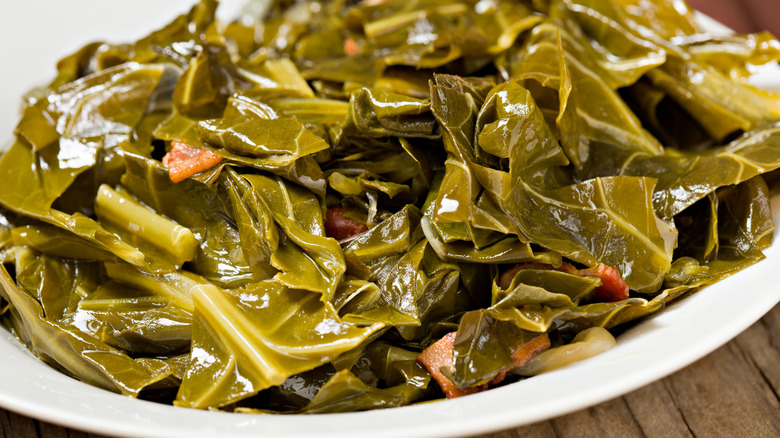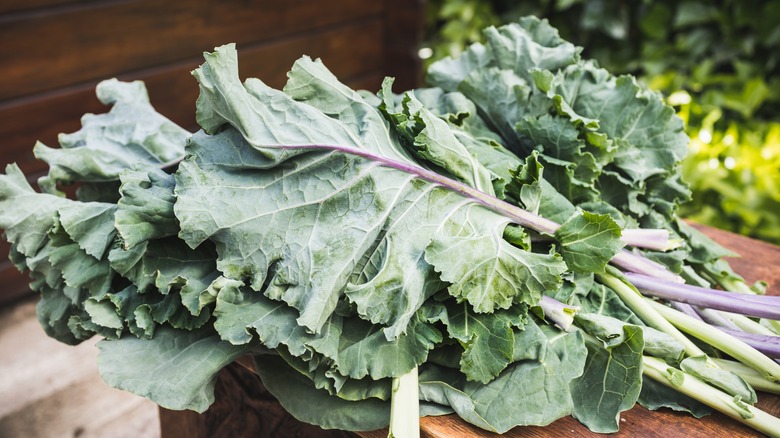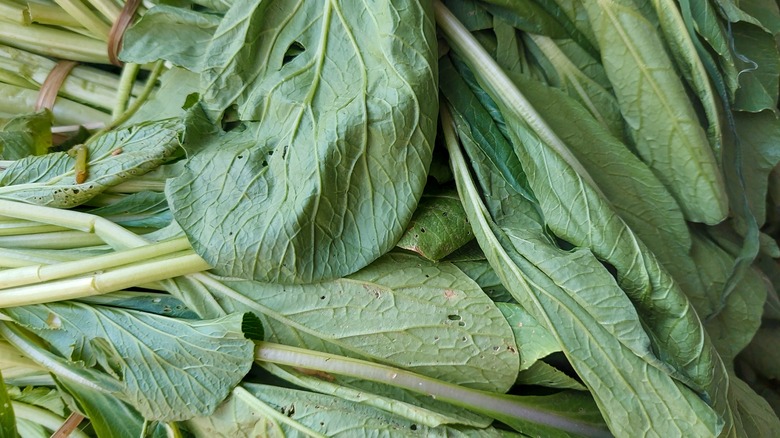The Precise Difference Between Collard And Mustard Greens
While collard greens and mustard greens are cousins rooted within the brassica family (a group that also includes kale and broccoli), these leafy vegetables hold key differences in taste and texture. Collard greens are hardier and possess a distinctly bitter flavor, whereas mustard greens boast a more peppery profile and delicate structure. This leads to key differences in how both ingredients are used in the kitchen.
Since collard leaves are thick and fibrous, they often require long, slow cooking methods, like stewing or braising, to soften them for recipes. Collards are often slow-cooked with smoked meat (like ham hocks or bacon) to draw out and balance their natural bitterness. Mustard leaves, on the other hand, are thinner, more tender, and lend themselves well to quick cooking methods like steaming and sauteing. Though raw mustard greens are enjoyed by many for their sharp, horseradish-like bite, most folks prefer to mellow the piquant bite of these greens by cooking them down with something like garlic.
Nutritionally, both greens are rich in vitamins A, C, and K, but mustard greens have higher levels of iron and calcium, and collard greens have a bit more protein.
What are collard greens?
As one of the oldest members of the brassica family, collards have evolved to be particularly hardy and weather resistant. The domestication of the plant can be traced back to the Mediterranean some 3000 years ago, but the culinary popularity of collards first exploded in the American South during the colonial period. As one of the few plants that enslaved Africans were allowed to keep, collards became a staple of the plantation diet and were traditionally prepared with pork off-cuts, like pigs feet. Many folks in the U.S. still cook collards in the traditional Southern style, braising them for a couple of hours with bacon or ham hocks.
Properly cleaning collard greens before use is crucial, as the large leaves can collect a fair amount of grit as they grow. To do so, simply wash each leaf one at a time under running water. Collards also have thick, woody stems that are generally too tough to eat and should be discarded prior to cooking. Many home cooks skip these steps by opting for canned collard greens, which come pre-cooked and can be upgraded easily by adding peppers, sausage, and even beer.
Folks in the deep South are also known to hold onto the liquid left after cooking collards (known as pot liquor) to repurpose into other broths and stews. In countries like Portugal and Brazil, collards are often added to beloved meat-based stews like caldo verde and feijoada. Collard greens even hold a revered place in Ethiopian cuisine, where they have long been a part of local Jewish culinary tradition.
What are mustard greens?
Most people are generally more familiar with the seeds of the mustard plant, which get turned into the popular tangy condiment found at every grocery store. However, the leaves of those same plants (of which there are dozens of varieties) carry their own bold and spicy taste that make them a delicacy in many parts of the globe.
Though mustard cultivation originated in the Himalayan region over 5000 years ago, the greens of the plant gained their culinary and medicinal popularity during the European Middle Ages. European settlers then brought mustard to the Americas in the 1500s, where they later became an agricultural cornerstone in states like Florida. Today, most of the world's mustard is grown in Canada, Nepal, and Russia.
While mustard greens aren't as tough as their collard cousins, they do still need to be trimmed of their stems and thoroughly washed before cooking. Soaking mustard greens in water for a few minutes will allow any lingering dirt and grit to sink. The clean leaves can then be used in a variety of delicious ways, like this scallion pancake-inspired recipe from chef Jenn Louis. A Chinese dish named Xuelihong calls for mustard greens to be stir-fried in sesame oil with garlic and dried red chilies. And in Vietnam, mustard greens are salted, sun dried, and fermented to make a sour side dish known as Dua Chua.



